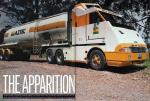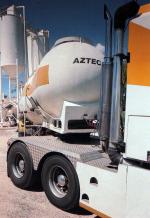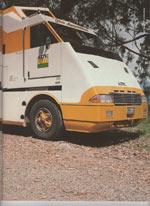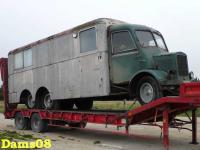John Horswell » Apparition
When John Horswell's Apparition was first sighted on the highways of New South Wales, it probably caused more commotion than if a UFO had landed on the Sydney Opera House and aliens had stolen the roof tiles.
Underneath this smart new mutant lies a Ford Louisville LNT9000 conventional, built in ’79, which John bought in '86. He’d signed on as a subbie with Aztec, to haul bulk cement powder, and though the truck had the best part of a million kms on the clock, was fine for starting out on the job to see if he could make ends meet. With the contract going well, but missing a sleeper for nights showing signs of serious tin worm, John had to make an important decision. For most owner-drivers the choice would have boiled down to a pair of options: either fit a new cab or buy a new truck. In John’s case buying a new truck was out of the question. Getting a new cab was also expensive, besides which replacing the LNT cab wouldn’t have given him a sleeper, as there was no room to squeeze a Ford LTL sleeper cab onto the chassis. John then considered a pretty unique third option: building a new cab himself, to his own design and specification.
Not wanting to fall foul of the red tape bureaucrats, John talked his ideas over with his state department of transport. All they required was that John’s new cab should match the ADR compliance of his old ’79 Louisville. To check the design was up to scratch technically, he had the drawing gone over by engineering consultant Bob Buckley. Meanwhile, by day, John continued hauling for Aztec. By night and at weekends his new cab gradually began to take shape in the workshop. The frame was MIG-welded into one rigid piece from 0.75 in x 0.75 in tubular steel. Cross braces were made from 0.5 in accept all the wiring, John began cladding the shell with 18 gauge Zincaneal panel sheeting. In spite of the solid construction of the cab, it’s by no means overweight, as one might expect of a home-brewed wagon. The rig tares off at 8.94 tonnes, or half a tonne lighter than a W900 Kenworth Aerodyne.
The tilting hood, which gives access to the radiator and batteries, was made from fiberglass and mounted on a steel frame. John fabricated the doors, fitted with International locks, handles and hinges. Glass is laminated throughout, for better safety and, since it's all flat, is easily and cheaply replaced for just around £50 a pane. Surprisingly, working out how to get the wipers to wipe properly took a huge amount of work.
In June '87, John took the ageing Louisville off the road to begin the long and complicated process of marrying the cab shell to the chassis. Considerable attention was paid to getting the weight distribution just right. John wanted a 5.5 tonne loading on the steer axle all the time, 16.5 tonnes on the drivers and 20 tonnes on the tri-axle trailer.
The Cummins Big Cam 1 motor that sits under the cab was sent off to Newtons Diesel for a rebuild. So were the Fuller 15-speed Roadranger and diffs. John wanted to do the job properly and not have his new truck sidelined by mechanical problems after going to all the trouble with the cab. However, he has also ensured that Cat, Detroit or newer Cummins motors will slot in under the new superstructure for the day when a new powerplant is necessary.
John didn’t stint on the necessities or luxuries a driver both needs and wants. The driving position offers excellent vision, both from its high viewpoint and the positioning of the screen pillars. With his mechanical background John likes to know exactly what's going on in the engine room and mechanicals department of his truck. It’s also important to him to know how the changed airflow is affecting his truck, too, and to this end there are VDO instruments worth about £1500 plumbed in to the dash.
These include temperature gauges for both diffs, the gearbox and engine as well as the exhaust, fuel and ambient air temperature. Other dials include boost, volts and a Murphy gauge. He's also fitted a VDO cruise control and fuel consumption meter, as well as a VDO engine protection pack.
At the end of a long day the sleeper comes close to offering the luxury of a five-star hotel. The bed’s huge, and there’s enough height in the Aerodyne-styled roof to let one stand up to dress and undress. What's more, John has even installed a shower with a 60 litre hot water tank, warmed by waste engine heat!
To ensure that the cab doesn’t succumb to rust as badly as its forerunner, John rustproofed the shell with Tectrol and the exterior has been finished off in Berger two-pack Permacron. The interior upholstery, in blue fabric, was handled by Tony Kerr, of Kdumba Upholstery.
John got his creation on the road in February ’88. The Apparition met for the most part with a mixture of admiration, envy and awe. Naturally there were a few detractors and pessimists, who predicted that the thing would shake itself to pieces over Australia's rough roads. But one year later, and with well over 100,000kms under the crank, John’s Apparition has been a constant sighting on the highways of New South Wales and the critics have had to eat their words.









